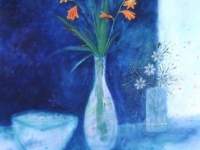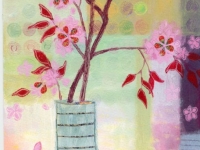Tracy Cupitt: Still-Lives: Stilled Love
Text by Michael Howard, M.A., F.R.S.A.
Traditionally, still-life paintings are domestic in intent and scale. They are painted to enhance the home, where they radiate a sense of meditative calm into the mêlée of the everyday.
Still life painting takes the ordinary and elevates it to a position of significance; in doing so the viewer is reminded of the beauty of ordinary things, offered a moment of solace and reassurance through its subject matter, colour, form and texture.
It is as if one was ‘seeing’ music – the same vocabulary applies: colour, rhythm, harmony, counterpoint, tone, colour, development, crescendo, and diminuendo. Each separate element of the picture’s composition holds a conversation with its partners, like instruments in a string quartet. For still-life is an intimate art made up of separable elements, each to be distinguished for their own qualities, their interaction with other instruments and, not least, the spaces left in between.
Tracy Cupitt has painted all her life, but her experience studying textiles at Manchester Metropolitan University and her recent residence in Japan affirmed her belief in the significance of the decorative and her respect for the craft traditions of different cultures.
In her paintings shapes and colours work together in perfect accord. Here there are colours of name and no name: burnt cinnamons, pale pinks, warm peach, smoky lemon yellow and violent orange glow against the coolness of ice blues, lime greens and deepest indigo.
These paintings are imbued with light, not from without, but, it seems from within. The light radiates from the imagined space in which these flowers, vases, jugs and fabric have their being to illuminate the world of the viewer. This is an ideal space, a space of the imagination, of the senses.
Guillaume Apollinaire, critic, poet and great friend of Picasso, wrote these lines,
‘Since then, I have tasted the bouquet of the world,
I am drunk from having drank the universe whole.’
These works offer a gentle inebriation of the senses as they mingle to create a quiet epiphany of delight.
Still-life painting stops time, it releases the world of the natural and the man-made from the shackles of purpose and gives, so to speak, ‘the apple back to the apple.’ Or, as William Blake declared in his ‘Auguries of Innocence’:
‘To see a world in a grain of sand
And a heaven in a wild flower,
Hold infinity in the palm of your hand
And eternity in an hour.’
These silent works speak for themselves. ‘Do not look for theories’, said the sculptor Constantin Brancusi, ‘what I give you is pure delight.’
Michael Howard
December 2010



